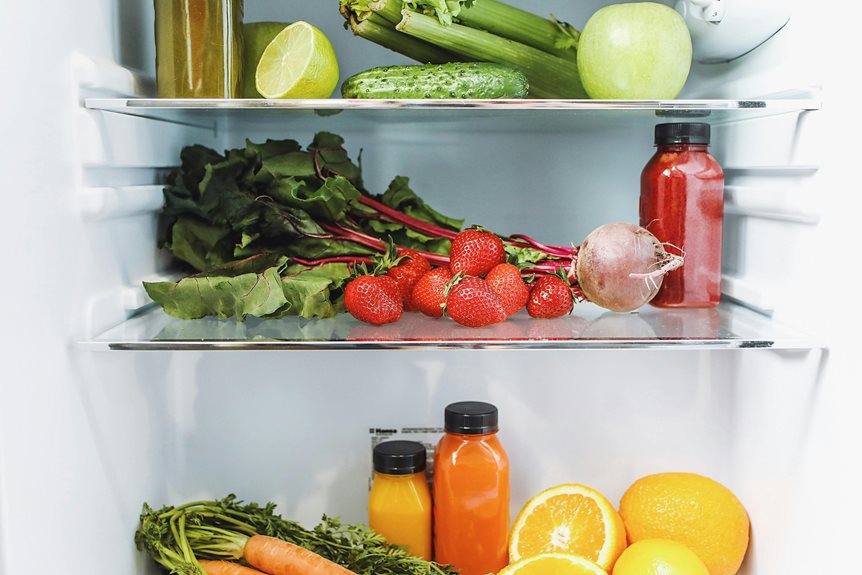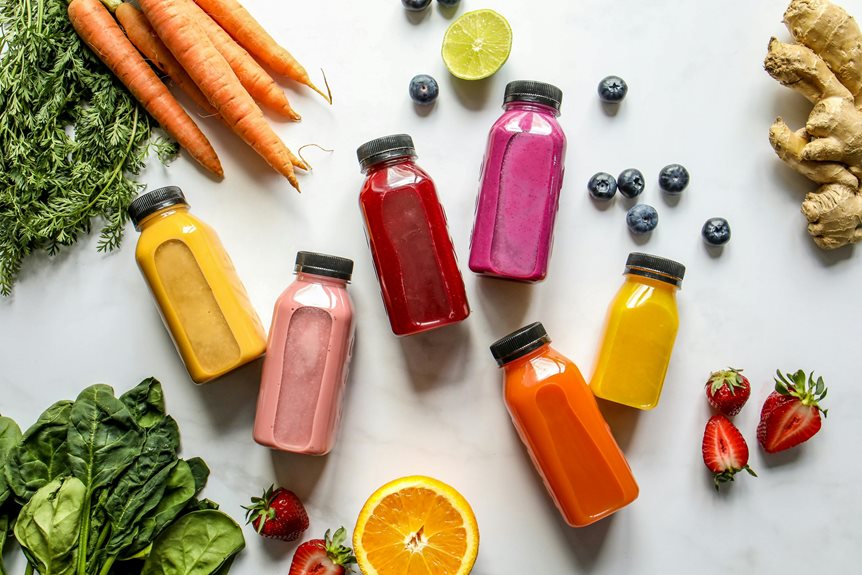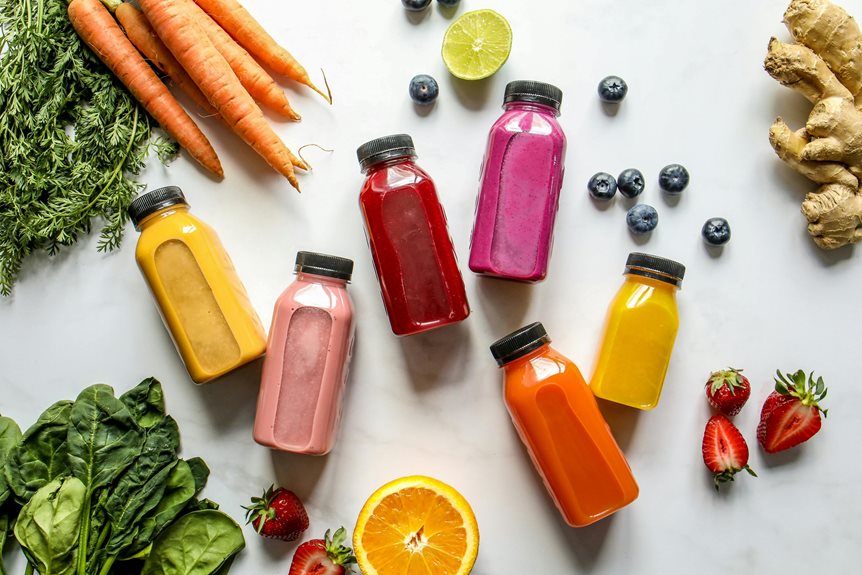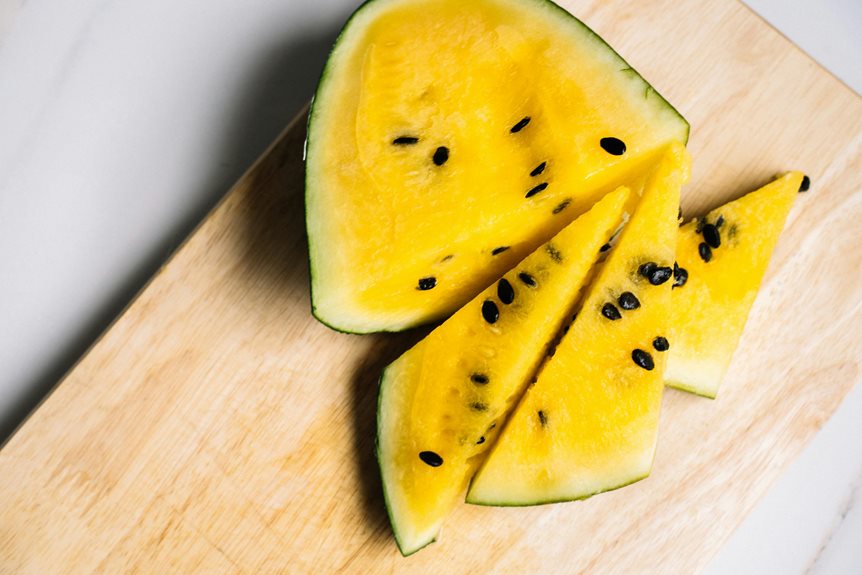To juice celery, first select crisp, organic stalks and rinse them thoroughly. Cut the stalks into 2-4 inch pieces, removing the base and leaves. Feed the pieces steadily into your juicer (masticating juicers work best for nutrient preservation). Strain the juice through a fine-mesh bag to remove foam, then drink immediately for maximum benefits. Store any leftover juice in an airtight glass container for up to 48 hours. There’s much more to discover about maximizing your celery juice experience.
Why Celery Juice Is a Game-Changer
When you’re looking to revolutionize your health routine, celery juice stands out as a powerhouse beverage packed with essential nutrients. You’ll get an impressive array of vitamins A, C, and K, plus crucial minerals like potassium and manganese, all for just 33 calories per cup.
You’re taking control of your health by harnessing celery juice’s powerful anti-inflammatory and antioxidant properties. Its compounds, including flavonoids and polyphenols, actively combat free radicals and reduce inflammation in your body. These properties are enhanced by celery’s natural healing compounds that help manage various chronic conditions. Celery juice supports cardiovascular health by increasing nitric oxide levels, which helps to expand and keep blood vessels healthy.
The high water content (95%) helps maintain your fluid balance while supporting healthy digestion.
What makes celery juice truly transformative is its multi-faceted impact: it regulates blood pressure, boosts immune function, aids liver detoxification, and supports skin health.
You’ll benefit from improved gut health thanks to its fiber content and natural electrolyte-balancing properties.
Essential Equipment and Tools
To maximize your celery juice benefits, selecting the right equipment makes all the difference. You’ll find three main juicer types: masticating, twin gear, and centrifugal. Each offers distinct advantages for your juicing goals. Masticating juicers, like the Omega NC900HDC, preserve nutrients through slow-speed extraction and are easy to clean. Operating at a gentle slow masticating speed, these juicers effectively break down celery’s tough fibers while maintaining optimal nutrient retention. Twin gear models, such as the Angel 5500, deliver the highest yield but come at a premium price. If speed’s your priority, centrifugal juicers process celery in under a minute, though the juice is less nutrient-dense. Dedicated wheatgrass juicers are recommended for handling fibrous produce like wheatgrass, highlighting the importance of choosing specific juicers for different types of produce. Consider features that’ll enhance your juicing experience: a large chute for minimal prep time, adjustable pulp outlets to prevent clogging, and a reverse function for easier cleaning. For best results, choose a juicer that aligns with your specific needs in yield, speed, and maintenance.
Selecting and Preparing Fresh Celery
The success of your celery juice begins with selecting the freshest, highest-quality stalks. Choose organic celery with crisp, firm stalks and vibrant green leaves. Avoid any bunches showing signs of wilting or yellowing, as these indicate age and potential bitterness.
To prepare your celery, start by cutting off the root base to separate the stalks. Thoroughly rinse them in a colander under running water to remove dirt and debris.
Next, trim the tops and decide whether you’ll use the leaves elsewhere or discard them. This preparation method helps preserve the celery’s powerful antioxidants like caffeic acid and ferric acid. Cut the stalks into 2-4 inch pieces to make juicing easier.
Keep your celery cold until you’re ready to juice it. If your stalks seem slightly limp, soak them in cold water for 30 minutes to revive their crispness before juicing.
Mastering the Juicing Technique
Successful celery juicing relies on three key elements: proper equipment setup, correct feeding technique, and consistent maintenance.
Start by setting your juicer to manual standards and verify you’ve got a collection jug ready beneath the spout. If you don’t have a juicer, you can also use a Vitamix blender to prepare your juice by blending the celery with water and then straining it.
Feed celery into your juicer at a steady pace, watching the auger pull each piece down before adding more. If you’re using a domestic juicer, cut stalks into 1-4 inch pieces to prevent jams. For industrial models, you can feed whole stalks directly. For best results, use freshly chilled celery from the refrigerator.
When you encounter resistance, use your tamper to guide the celery, or hit the reverse button to dislodge stuck pieces.
Keep an eye on the process and don’t overload your machine. If it stops, turn it off immediately and clear any blockage before continuing.
Clean your juicer right after use to maintain peak performance.
Straining and Storage Best Practices
While celery juice tastes great straight from the juicer, proper straining and storage techniques will maximize its quality and shelf life.
Strain your juice through a fine-mesh nut bag or cheesecloth, squeezing gently to extract liquid without introducing excess air. Remove any foam from the top for better texture. For optimal nutrition, use organic celery stalks when making your juice.
Store your strained juice in an airtight glass container, leaving headspace if you plan to freeze it later. Place it in the coldest part of your refrigerator, maintaining temperatures between 32°F and 40°F.
You’ll want to consume the juice within 24-48 hours for best nutritional benefits, though it can last up to 72 hours when properly stored.
For longer storage, freeze your juice in freezer-safe containers, making sure to label them with the date of juicing.
Health Benefits and Nutritional Value
Fresh celery juice offers more than just proper storage practices – it’s a powerhouse of nutrients and health-promoting compounds that can transform your well-being.
When you drink celery juice regularly, you’ll harness its potent anti-inflammatory and antioxidant properties, which combat free radicals and support cellular health. Celery’s heart health benefits are enhanced when combined with other ingredients like apples and ginger, offering a refreshing and nutritious blend.
You’ll benefit from its impressive nutritional profile, including vitamins A, C, and K, along with essential minerals like potassium and magnesium. Those on blood-thinning medications should monitor consumption due to its high vitamin K content.
With only 33 calories per cup, you’ll get 4g of fiber and nearly 2g of protein, making it an efficient choice for health-conscious individuals.
The juice’s high water content (95%) and natural electrolytes will optimize your hydration levels, while its bioactive compounds support digestion, immune function, and detoxification.
You’ll also maintain healthier skin and strengthen your body’s natural defense systems.
Common Mistakes to Avoid When Juicing
Making celery juice at home requires attention to detail, as even small mistakes can greatly impact the nutritional value and safety of your drink. Proper preparation starts with thoroughly washing your celery to remove bacteria and pesticides, even if it’s organic.
Don’t roughly chop the stalks, as this can lead to nutrient loss. For optimal nutrient absorption, it’s best to drink your celery juice on an empty stomach.
Choose the right juicer for ideal results. You’ll want to use a masticating or cold-press juicer instead of a centrifugal one to prevent heat-induced nutrient degradation. Follow your juicer’s instructions carefully to maintain nutritional integrity.
Store your celery juice properly by filling containers to the rim and sealing them tightly to minimize oxidation. Place them in the freezer for the first 30 minutes, then transfer to the refrigerator.
Consume within 2-3 days to get maximum nutritional benefits.
Tips for Enhancing Your Celery Juice
To elevate your celery juice experience, you can explore various enhancing ingredients that complement its natural benefits. Add green apple or watermelon for natural sweetness, or incorporate cucumber to boost hydration. For a zesty kick, squeeze in fresh lemon or lime juice. Boost your juice’s flavor profile by adding fresh herbs like mint or parsley. Ginger creates a warming sensation and pairs exceptionally well with mint. You’ll maximize nutritional benefits by choosing organic celery and consuming your juice immediately on an empty stomach. Store any leftover juice in an airtight container for up to three days, though fresh is always best. Including orange juice due to its high vitamin C content can further enhance skin benefits by promoting collagen synthesis and reducing inflammation.






Konnichiwa! (Hello!) I'm Pat Tokuyama, a Japanese tofu cookbook author, who travels for music, food, and adventure. If you like Japanese tea, checkout some of the newestorganic japanese tea, matcha bowls and noren and more!
** Curious about the Plant Based Japanese Cooking Club? ** Learn more here!